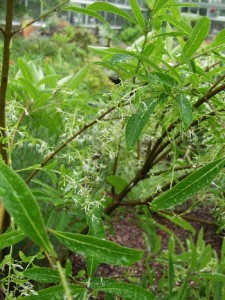Chionanthus /ˌkaɪ.ɵˈnænθəs/, common name: fringetrees, is a genus of about 150 species of flowering plants in the family Oleaceae. The genus has a wide distribution primarily in the tropics and subtropics, but with three species extending north into temperate regions, one (C. retusus) in eastern Asia and two (C. virginicus and C. henryae) in eastern North America. Most of the tropical species are evergreen, while the three temperate species are deciduous.
Contents
Uses
The roots of the fringe tree are dried and used to treat liver and gallbladder disease in traditional American folk medicine, often in combination with barberry and other herbs containing berberine. The root acts as a bitter,stimulating release of bile, which increases gastric secretion and improved appetite and digestion.
Hepatorestorative (liver supporting) and cholerectic (increasing bile) herbs such as St. Mary’s thistle (Cnicus benedictus), fringe tree (Chionanthus virginicus) and schisandra (Schisandra chinensis) are an important part of treatment for IBS.
Benefits
The fringe tree was commonly used by the North American Indians and European settlers alike to treat inflammations of the eye, mouth ulcers and spongy gums. In modern herbalism it is considered to be one of the most reliable remedies for disorders of the liver and gall bladder. The dried root bark is alterative, aperient, cholagogue, diuretic, febrifuge and tonic. It is used in the treatment of gallbladder pain, gallstones, jaundice and chronic weakness. A tincture of the bark was once widely used internally in the treatment of hypertrophy of the liver, jaundice, bilious headache, gallstones, rheumatism etc. The root bark also appears to strengthen function in the pancreas and spleen whilst anecdotal evidence indicates that it may substantially reduce sugar levels in the urine. Fringe tree also stimulates the appetite and digestion and is an excellent remedy for chronic illness, especially where the liver has been affected. A tea or a poultice can be made from the root bark for external use as a wash for wounds, inflammations, sores, infections etc. The roots can be harvested at any time of the year, the bark is peeled from them and is then dried for later use.
Cautions
No side effects.
Interactions
None are recorded. Please seek your doctor’s opinion.
Other names
n/a
References
Source: NaturalMedicinalHerbs, http://www.naturalmedicinalherbs.net/herbs/c/chionanthus-virginicus=fringe-tree.php
Wikipedia, https://en.wikipedia.org/wiki/Chionanthus
AnnieRemedy, http://www.anniesremedy.com/herb_detail480.php

